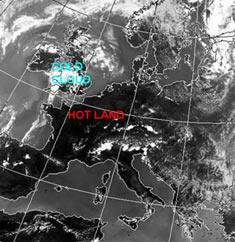 The paper “Assimilation of vertical motion from simulated cloudy satellite imagery in an idealised single column model“, co-authored by Matthew Wakeling (EngD Student), John Eyre (Metoffice), Sue Hughes (Engineering, Surrey) and Ian Roulstone, has been accepted for publication in the Quarterly Journal of the Royal Meteorological Society. Satellite infra-red sounders are invaluable tools for making observations of the structure of the atmosphere. They provide much of the observational data used to initialise atmospheric models, especially in regions that do not have extensive surface-based observing systems, such as oceans.
The paper “Assimilation of vertical motion from simulated cloudy satellite imagery in an idealised single column model“, co-authored by Matthew Wakeling (EngD Student), John Eyre (Metoffice), Sue Hughes (Engineering, Surrey) and Ian Roulstone, has been accepted for publication in the Quarterly Journal of the Royal Meteorological Society. Satellite infra-red sounders are invaluable tools for making observations of the structure of the atmosphere. They provide much of the observational data used to initialise atmospheric models, especially in regions that do not have extensive surface-based observing systems, such as oceans.
However, in the presence of cloud, information is lacking, as the cloud layer is opaque to infra-red radiation. This means that where information is most desired (such as a developing storm), it is often in shortest supply. In order to explore the mathematics of assimilating data from cloudy radiances, a study has been performed using an idealised single column atmospheric model. The model simulates cloud development in an atmosphere with vertical motion, allowing the characteristics of a 2D-Var data assimilation system using a single simulated infra-red satellite observation taken multiple times to be studied. The strongly non-linear nature of cloud formation poses a challenge for variational methods. The adjoint method produces an accurate gradient for the cost function, and minimisation is achieved using preconditioned conjugate gradients. The conditioning is poor, and varies strongly with the atmospheric variables, and the cost function has multiple minima, but acceptable results are achieved. The assimilation system is provided with a prior forecast simulated by adding random correlated Gaussian error to the truth. Assimilating observations comparable to those available from current geostationary satellites allows vertical motion to be retrieved with error of less than a centimetre per second in most conditions. Moreover, evaluating the second derivative of the cost function at the minimum provides an estimate of the uncertainty in the retrieval. This allows atmospheric states that do not provide sufficient information for retrieval of vertical motion to be detected (such as a cloudless atmosphere or a non-moving opaque cloud layer in the upper troposphere). Retrieval is most accurate with upwards motion. The final form manuscript will be uploaded to the journal Early View in due course.
